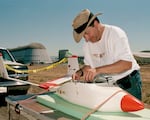NASA is poised to make aerospace history with the planned launch of the Ingenuity Mars Helicopter. It will be the first flight by a controlled aircraft on another planet beyond Earth.
Decades of planning and prototype testing have led up to this moment. And a piece of that history happened on the Oregon Coast.
“The problem on any planet is the same as Earth. If you want to go around a bunch, you have to go in orbit. To be in orbit, your altitudes are significantly higher than if you could fly,” said Kevin Tucker, president of aerospace engineering company Near Space Corporation. “If you really want to get sensors in close proximity where you can get more measurements on both the ground and the atmosphere, you have to go lower.”
Ingenuity’s launch was planned for Sunday but NASA has delayed that to Wednesday, at the earliest. In the years leading up to this event, scientists with NASA have been trying to figure out if it’s possible to fly an aircraft in the low gravity and thin atmosphere of Mars. And before there was the Ingenuity helicopter, there was the NASA 731 glider, nicknamed “Orville.”

NASA 731, Orville, is prepared for a low altitude hop (1,000 ft.) at Ames Research Center on Moffet Field in California to checkout aircraft and data systems.
NASA / NASA
This is where Tillamook-based Near Space Corporation came in. It was contracted to do the flight tests for the glider at the Tillamook Airport.
On a Thursday in August 2001, the sky was blue and clear and the winds calm. A crew of about a dozen started filling a giant helium balloon more than 100 feet tall.
“The Martian atmosphere is extremely less dense than Earth. So to fly — to simulate the atmosphere of Mars on Earth — you have to go a lot higher where the density of the atmosphere is much, much lower,” Tucker said.
As the balloon rose into the sky, what started out as a “loose, floppy-looking bag” started to fill up as the helium inside expanded. The balloon eventually carried the glider more than 19 miles up into the stratosphere, before releasing it.
As the glider drifted back to Earth, engineers monitored its progress.
“The tests did what (they were) supposed to do. The thing flew,” Tucker said.
NASA later explained, “The aerodynamic lift on the wings first exceeded the weight of the aircraft at an altitude of 29.9 km, thereby proving that flight at Mars-like conditions is both aerodynamically possible and predictable.”
But Orville’s success in Tillamook would not be repeated. A year later the glider was fitted with a high-speed propeller to test if propulsion was possible. Orville disintegrated 20 miles above the earth.
Still, the legacy of lessons learned in Tillamook carries through and helped shape the design of the Ingenuity helicopter, which will begin a series of test flights on Mars this weekend.
“It’s built on technology efforts that go back decades,” said Dave Lavery, NASA’s program executive for solar system exploration.
In addition to helicopters and gliders, NASA has considered if balloons and other aircraft could be used on other planets or moons in the solar system.

NASA's Ingenuity Mars helicopter is seen here in a close-up taken by Mastcam-Z, a pair of zoomable cameras aboard the Perseverance rover. This image was taken on April 5, 2021.
NASA / NASA
“The fundamental research, the attempts to understand what flying in atmospheres besides earth would be like. Things as simple as the shape of the airfoil that you need to fly in a very, very thin atmosphere — that stuff we’ve been working on for decades,” he said.
Lavery said if Ingenuity’s upcoming flight shows that flying on Mars is possible, the other technologies will still be in the mix. And that means Tillamook’s legacy in advancing Mars exploration could be even more meaningful in the decades ahead.
“They wanted to show that this is a viable way to position sensing sensors above Mars. And that proved successful,” Tucker said. “So while it hasn’t been implemented in a mission to Mars yet, nothing says it won’t be.”
